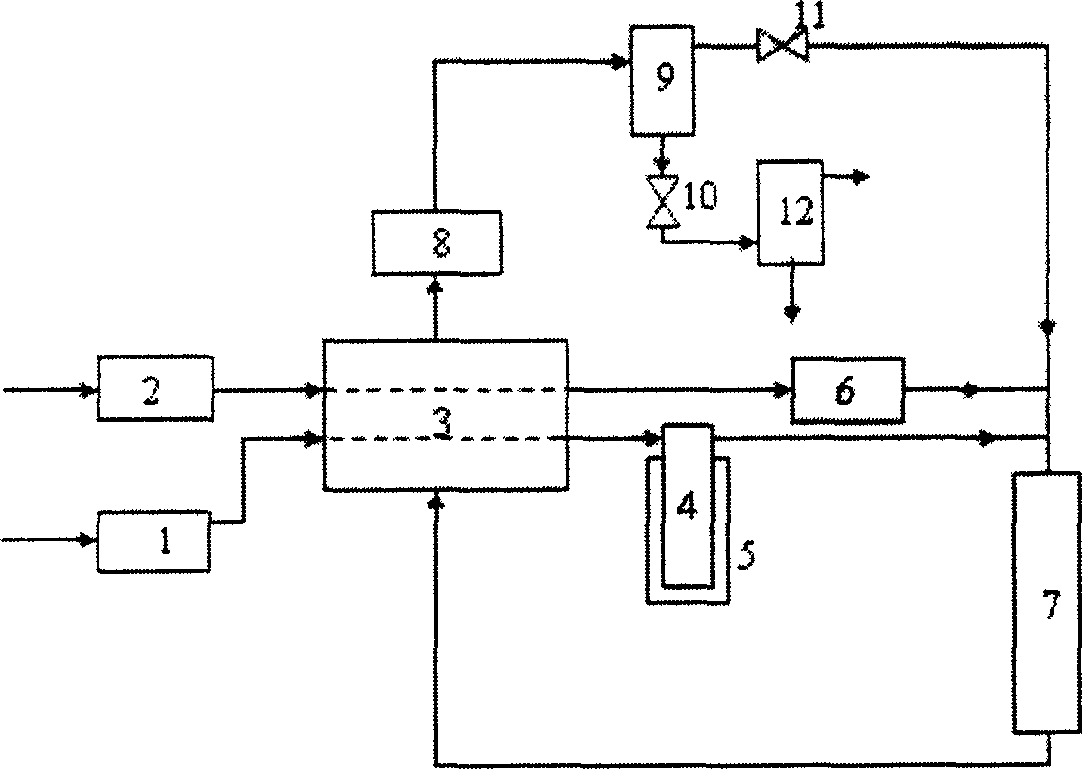Method of sewage oxidation treatment using supercritical water
A technology for supercritical water oxidation and waste water treatment, which is applied in the direction of oxidized water/sewage treatment, water/sewage treatment, chemical instruments and methods, etc. It can solve the problems of high process operation control requirements, affecting the stable operation of the reactor, and reactor structure design. Complexity and other issues, to achieve the effect of simple process
- Summary
- Abstract
- Description
- Claims
- Application Information
AI Technical Summary
Problems solved by technology
Method used
Image
Examples
Embodiment 1
[0033] The untreated coking wastewater was treated with supercritical water oxidation, and the properties of the wastewater used are shown in Table 1. The raw water of coking wastewater is pressurized to 25MPa by the high-pressure metering pump 1, passes through the heat exchanger 3, and the temperature is 350°C after preheating, and then enters the salt separator 4 with a temperature of 600°C. Ozone is pressurized to 25MPa by the high-pressure metering pump 2 with an oxidant amount about 6 times the theoretical oxygen demand, then heat exchanged by the heat exchanger 3, and then further heated to 580°C by the heater 6. Then, it is mixed with wastewater at the inlet of reactor 7 at a mixing temperature of 594° C., and then flows through reactor 7. The fluid residence time in reactor 7 is 13.4 seconds, and the outlet temperature of reactor 7 is 610° C. The reactor 7 supplements the heat lost when the fluid flows through the reactor 7 through external heating. The effluent flow...
Embodiment 2
[0035] The supercritical water oxidation treatment was carried out on the untreated coking wastewater, and the quality of the wastewater used was the same as that in Example 1. The raw water of coking wastewater is pressurized to 23MPa by the reciprocating pump 1, passes through the heat exchanger 3 at a certain flow rate, and the temperature is 360°C after preheating, and then enters the salt separator 4 with a temperature of 580°C. After the hydrogen peroxide is diluted, it is pressurized to 23 MPa by the high-pressure metering pump 2 with an oxidant amount about 4 times the theoretical oxygen demand, then the heat is exchanged by the heat exchanger 3, and then the temperature is further raised to 590°C by the heater 6. Then, it is mixed with waste water at the inlet of the reactor 7 at a mixing temperature of 584°C, and then flows through the reactor 7, the residence time of the fluid in the reactor 7 is 13.6s, and the outlet temperature of the reactor 7 is 590°C. The rest ...
Embodiment 3
[0037]The supercritical water oxidation treatment was carried out on the untreated coking wastewater, and the quality of the wastewater used was the same as that in Example 1. The raw water of coking wastewater is pressurized to 26MPa by the reciprocating pump 1, passes through the heat exchanger 3 at a certain flow rate, and the temperature is 370°C after preheating, and then enters the salt separator 4 with a temperature of 590°C. After dilution, the hydrogen peroxide is pressurized to 26MPa by the high-pressure metering pump 2 with an oxidant amount about 4 times of the theoretical oxygen demand, then the heat is exchanged by the heat exchanger 3, and then the temperature is further raised to 610°C by the heater 6. Then, it is mixed with waste water at the inlet of the reactor 7 at a mixing temperature of 604°C, and then flows through the reactor 7, the residence time of the fluid in the reactor 7 is 18.3s, and the outlet temperature of the reactor 7 is 600°C. The rest are ...
PUM
 Login to View More
Login to View More Abstract
Description
Claims
Application Information
 Login to View More
Login to View More - R&D
- Intellectual Property
- Life Sciences
- Materials
- Tech Scout
- Unparalleled Data Quality
- Higher Quality Content
- 60% Fewer Hallucinations
Browse by: Latest US Patents, China's latest patents, Technical Efficacy Thesaurus, Application Domain, Technology Topic, Popular Technical Reports.
© 2025 PatSnap. All rights reserved.Legal|Privacy policy|Modern Slavery Act Transparency Statement|Sitemap|About US| Contact US: help@patsnap.com

